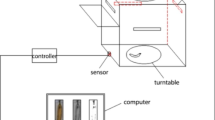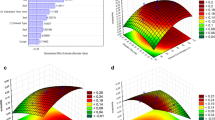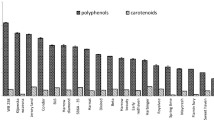Abstract
To ascertain the most discriminant variables for three pumpkin species principal component analysis (PCA) was performed. Twenty-four parameters (pH, conductivity, sucrose, glucose, total soluble solids, L*, a*, b*, individual weight, edible rate, firmness, citric acid, fumaric acid, l-ascorbic acid, malic acid, PPO activity, POD activity, total flavonoids, vitamin E, total phenolics, DPPH, FRAP, β-carotene, and aroma) were considered. The studied pumpkin species were Cucurbita maxima, Cucurbita moschata, and Cucurbita pepo. Three pumpkin species were classified by PCA based on aroma, physicochemical and antioxidant properties because the sum of PC1 and PC2 were both greater than 85% (85.06 and 93.64% respectively). Results were validated by the PCA and showed that PPO activity, total flavonoid, sucrose, glucose, TSS, a*, pH, malic acid, vitamin E, DPPH, FRAP and β-carotene, and aroma are highly useful parameters to classify pumpkin species.



Similar content being viewed by others
Abbreviations
- DPPH:
-
1,1-Diphenyl-2-picrylhydrazyl
- E-nose:
-
Electronic nose
- FRAP:
-
Ferric reducing antioxidant power
- FW:
-
Fresh weight
- SPME-GC–MS:
-
Solid phase micro-extraction-gas chromatography–mass spectrometry
- TSS:
-
Total soluble solids
- PCA:
-
Principal component analysis
- POD:
-
Peroxidase
- PPO:
-
Polyphenol oxidase
References
Applequist WL, Avula B, Schaneberg BT, Wang YH, Khan IA (2006) Comparative fatty acid content of seeds of four Cucurbita species grown in a common (shared) garden. J Food Compos Anal 19(6–7):606–611
Biesiada A, Nawirska A, Kucharska A, Sokół-Łętowska A (2009) The effect of nitrogen fertilization methods on yield and chemical composition of pumpkin (Cucurbita maxima) fruits before and after storage. Veg Crops Res Bull 70(1):203–211
Cheng H, Chen J, Chen SG, Wu D, Liu DH, Ye XQ (2015) Characterization of aroma-active volatiles in three Chinese bayberry (Myrica rubra) cultivars using GC–MS–olfactometry and an electronic nose combined with principal component analysis. Food Res Int 72:8–15
Chisari MR, Barbagallo N, Spagna G (2008) Characterization and role of polyphenol oxidase and peroxidase in browning of fresh-cut melon. J Agric Food Chem 56:132–138
Conti S, Villari G, Amico E, Caruso G (2015) Effects of production system and transplanting time on yield, quality and antioxidant content of organic winter squash (Cucurbita moschata Duch.). Sci Hortic Amst 183:136–143
Di Marco G, Gismondi A, Canuti L, Scimeca M, Volpe A, Canini A (2014) Tetracycline accumulates in Iberis sempervirens L. through apoplastic transport inducing oxidative stress and growth inhibition. Plant Biol 16(4):792–800
Dini I, Tenore GC, Dini I (2013) Effect of industrial and domestic processing on antioxidant properties of pumpkin pulp. LWT-Food Sci Technol 53(1):382–385
Dutta D, Dutta A, Raychaudhuri U, Chakraborty R (2006) Rheological characteristics and thermal degradation kinetics of beta-carotene in pumpkin puree. J Food Eng 76(4):538–546
Gonçalves EM, Pinheiro J, Abreu M, Brandão TRS, Silva CLM (2007) Modelling the kinetics of peroxidase inactivation, colour and texture changes of pumpkin (Cucurbita maxima L.) during blanching. J Food Eng 81(4):693–701
Guerrero-Beltrán JA, Swanson BG, Barbosa-Cánovas GV (2005) Inhibition of polyphenol oxidase in mango puree with 4-hexylresorcinol, cysteine and ascorbic acid. LWT-Food Sci Technol 38(6):625–630
Hu WZ, Jiang AI, Chen C, Tian MX, Liu CH, Jia L (2013) Effects of 2,5-norbornadiene(NBD)on physiological and biochemical responses of fresh-cut winter squash. J Food Sci Eng 3:123–130
Impei S, Gismondi A, Canuti L, Canini A (2015) Metabolic and biological profile of autochthonous Vitis vinifera L. ecotypes. Food Funct 6(5):1526–1538
Itle RA, Kabelka EA (2009) Correlation between L*a*b* color space values and carotenoid content in pumpkins and squash (Cucurbita spp.). HortScience 44(3):633–637
Jacobo-Valenzuela N, Maróstica-Junior MR, Zazueta-MoralesJDJ Gallegos-Infante JA (2011) Physicochemical, technological properties, and health-benefits of Cucurbita moschata Duchense vs Cehualca. Food Res Int 44(9):2587–2593
Jiao J, Li ZG, Gai QY, Li XJ, Wei FY, Fu YJ, Ma W (2014) Microwave-assisted aqueous enzymatic extraction of oil from pumpkin seeds and evaluation of its physicochemical properties, fatty acid compositions and antioxidant activities. Food Chem 147:17–24
Kafkas E, Koşar M, Türemiş N, Başer KHC (2006) Analysis of sugars, organic acids and vitamin C contents of blackberry genotypes from Turkey. Food Chem 97(4):732–736
Kim MY, Kim EJ, Kim YN, Choi C, Lee BH (2012) Comparison of the chemical compositions and nutritive values of various pumpkin (Cucurbitaceae) species and parts. Nutr Res Pract 6(1):21–27
Kourkoutas D, Elmore JS, Mottram DS (2006) Comparison of the volatile compositions and flavour properties of cantaloupe, Galia and honeydew muskmelons. Food Chem 97(1):95–102
Kreck M, Kürbel P, Ludwig M, Paschold PJ, Dietrich H (2006) Identification and quantification of carotenoids in pumpkin species (Cucurbita maxima L.) and their juices by liquid chromatography with ultraviolet-diode array detection. J Appl Bot Food Qual 80:93–99
Laureati M, Buratti S, Bassoli A, Borgonovo G, Pagliarini E (2010) Discrimination and characterisation of three species of Perilla frutescens by means of sensory descriptors and electronic nose and tongue analysis. Food Res Int 43(4):959–964
Leffingwell JC, Alford ED, Leffingwell D (2015) Identification of the volatile constituents of raw pumpkin (Cucurbita pepo L.) by dynamic headspace analyses. Leffingwell Rep 9(1):1–14
Leizerson S, Shimoni E (2005) Effect of ultrahigh-temperature continuous ohmic heating treatment on fresh orange juice. J Agric Food Chem 53(9):3519–3524
Liu FX, Fu SF, Bi XF, Chen F, Liao XJ, Hu XS, Wu JH (2013) Physico-chemical and antioxidant properties of four mango (Mangifera indica L.) species in China. Food Chem 138(1):396–405
LópezdeLerma N, Moreno J, Peinado RA (2013) Determination of the optimum sun-drying time for Vitis vinifera L. cv. Tempranillo Grapes by E-nose analysis and characterization of their volatile composition. Food Bioprocess Tech 7(3):732–740
MacDonald L, Schaschke CJ (2000) Combined effect of high pressure, temperature and holding time on polyphenol oxidase and peroxidase activity in banana (Musa acuminata). J Sci Food Agric 80:719–724
Murkovic M, Mülleder U, Neunteufl H (2002) Carotenoid content in different varieties of pumpkins. J Food Compos Anal 15(6):633–638
Nawirska-Olszanska A, Kita A, Biesiada A, Sokol-Letowska A, Kucharska AZ (2013) Characteristics of antioxidant activity and composition of pumpkin seed oils in 12 species. Food Chem 139(1–4):155–161
Neves FIG, Vieira MC, Silva CLM (2012) Inactivation kinetics of peroxidase in zucchini (Cucurbita pepo L.) by heat and UV-C radiation. Innov Food Sci Emerg 13:158–162
Oloyede FM, Agbaje GO, Obuotor EM, Obisesan IO (2012) Nutritional and antioxidant profiles of pumpkin (Cucurbita pepo Linn.) immature and mature fruits as influenced by NPK fertilizer. Food Chem 135(2):460–463
Perry L, Wang Y, Lin J (2009) Analysis of honeydew melon (Cucumis melovar. inodorus) flavour and GC–MS/MS identification of (E, Z)-2,6-nonadienyl acetate. Flavour Frag J 24:341–347
Provesi JG, Dias CO, Amante ER (2011) Changes in carotenoids during processing and storage of pumpkin puree. Food Chem 128(1):195–202
Qin ZH, Pang XL, Chen D, Cheng H, Hu XS, Wu JH (2013) Evaluation of Chinese tea by the electronic nose and gas chromatography–mass spectrometry: correlation with sensory properties and classification according to grade level. Food Res Int 53(2):864–874
Rezig L, Chouaibi M, Msaada K, Hamdi S (2012) Chemical composition and profile characterisation of pumpkin (Cucurbita maxima) seed oil. Ind Crop Prod 37(1):82–87
Roura SI, Del Valle CE, Aguero L, Davidovich LA (2007) Changes in apparent viscosity and vitamin retention during thermal treatment of butternut squash (Cucurbita moschata DUCH) pulp: effect of ripening stage. J Food Qual 30:538–551
Sampedro F, Phillips J, Fan X (2014) Use of response surface methodology to study the combined effects of UV-C and thermal processing on vegetable oxidative enzymes. LWT-Food Sci Technol 55(1):189–196
Shahdadi F, Mirzaei HO, Daraei GA (2015) Study of phenolic compound and antioxidant activity of date fruit as a function of ripening stages and drying process. J Food Sci Tech 52(3):1814–1819
Stevenson DG, Eller J, Wang LP, Jane J, Wang T, Inglett GE (2007) Oil and tocopherol content and composition of pumpkin seed oil in 12 species. J Agric Food Chem 55:4005–4103
Tyagi G, Jangir DK, Singh P, Mehrotra R, Ganesan R, Gopal ESR (2014) Rapid determination of main constituents of packed juices by reverse phase-high performance liquid chromatography: an insight into commercial fruit drinks. J Food Sci Tech 51(3):476–484
Verzera A, Dima G, Tripodi G, Ziino M, Lanza CM, Mazzaglia A (2010) Fast quantitative determination of aroma volatile constituents in melon fruits by headspace–solid-phase microextraction and gas chromatography-ass spectrometry. Food Anal Method 4(2):141–149
Zhou CL, Liu W, Zhao J, Yuan C, Song Y, Chen D, Ni YY, Li QH (2014) The effect of high hydrostatic pressure on the microbiological quality and physical–chemical characteristics of Pumpkin (Cucurbita maxima Duch.) during refrigerated storage. Innov Food Sci Emerg 21:24–34
Zinash A, WorknehTS Woldetsadik K (2013) Effect of accessions on the chemical quality of fresh pumpkin. Afr J Biotechnol 12(51):7092–7098
Acknowledgements
This work was supported by the Natural Science Foundation of Jiangxi Province, China (Grant No. 20151BAB204039), Doctoral Research Startup Fund Project of Jiangxi Science and Technology Normal University (3000990310), and Quality engineering projects of Jiangxi province (Biological chemistry curriculums, 2015).
Author information
Authors and Affiliations
Corresponding author
Rights and permissions
About this article
Cite this article
Zhou, CL., Mi, L., Hu, XY. et al. Evaluation of three pumpkin species: correlation with physicochemical, antioxidant properties and classification using SPME-GC–MS and E-nose methods. J Food Sci Technol 54, 3118–3131 (2017). https://doi.org/10.1007/s13197-017-2748-8
Revised:
Accepted:
Published:
Issue Date:
DOI: https://doi.org/10.1007/s13197-017-2748-8




